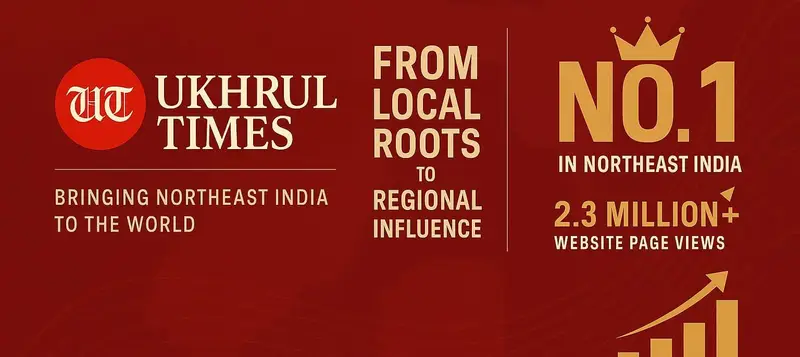Now Reading: Kiren Rijiju apprised by Manipur tribal students on Meitei ST demand
-
01
Kiren Rijiju apprised by Manipur tribal students on Meitei ST demand
Kiren Rijiju apprised by Manipur tribal students on Meitei ST demand

Imphal: After meeting and submitting a memorandum to Arjun Munda, Union Cabinet Minister of Tribal Affairs, Government of India, on Saturday in New Delhi, the All Tribal Students’ Union Manipur (ATSUM) met Union Law and Justice minister, Kiren Rijiju today in New Delhi on the issue of the Meitei/Meetei community’s demand for the inclusion of the community in the Scheduled Tribe list of India and submitted a similar memorandum. The apex tribal student body of Manipur has been camping in New Delhi since the past two days opposing the Meitei/Meetei community’s demand of the ST status.
In its memorandum submitted to Kiren Rijiju, the ATSUM said that there is a sense of insecurity felt by the tribal people of Manipur State “due to the illogical and illegitimate demand of the Scheduled Tribe Demand Committee of Manipur (STDCM) for inclusion of Meetei/Meitei community in the Scheduled Tribe (ST) category.” In this regard, ATSUM also submitted a memorandum to the Union Minister pointing out the valid reasons why the Meitei community should not be given ST status, the ATSUM said.
“After patiently hearing out the woes of the Manipur tribal students’ leaders, the Union Minister appealed to the ATSUM team to remain calm, saying that as the matter being constitutional it will be examined minutely before any decision is made,” the ATSUM said.
Also read | ATSUM meets Tribal Affairs Union minister Arjun Munda
The ATSUM said that, in the event of the demand for inclusion of Meitei/Meetei community in the ST category gaining momentum with most of the legislators from the valley including the MP (RajyaSabha) openly declaring their support without taking into account the “irrationality” of the demand and sentiments of the tribal community of the state, it was “constrained to submit this representation as a reminder for utmost perusal and intervention as the future of the tribal communities looks bleak and uncertain.”
Time and again, the ATSUM said it “unequivocally expresses” its stated position on this contested demand of the majority community as it posed serious threat to the land and existence of tribal people with the empirical reasoning that the Meetei/Meitei communities are an advanced community marked by 2000 years of civilization, unbroken lineage of kingship, superlative cultural advancement with its exquisite classical dances purportedly shown as the finest form of arts, Meitei Language (Manipuri) recognised under the Eight Schedule of the Indian constitution, urban civilization for eons, participation and signing of international treaties with the British in 1762 AD and 1826 AD, academic advancement with high literacy rate.
Also read | Manipur to host Femina Miss India 2023, signs MoU with Times Group
The ATSUM memorandum then said, “The fact that the Meetei/Meitei community has done exceedingly well in the fields of technology, medical, engineering, sports and civil services under UPSC is indicative of their advancement.” For instances, according to the ATSUM memorandum, 15 students from the community cracked the NDA examination last year, two civil service this year and the bulk of MBBS successful students in the whole North-Eastern states came from the Meetei/Meitei community. “It may be noted that all the state and central higher educational institutes in Manipur are concentrated in the Meitei dominated valley districts, particularly Imphal East and Imphal West districts. Recruitments conducted in all these institutions under Unreserved (UR) category are being filled up by the members of the Meitei community. This is just one of the evidences to show that the Meiteis are an advanced community rather than backward,” it stated.
Presently, the ST of Manipur have 31% reservation in all state government services, the ATSUM memorandum mentioned. “If the advanced Meitei community is recognised as ST by the government, all the seats reserved for ST in the present will be occupied by the Meiteis. Despite already availing the reservations from SC and OBC categories, the Meiteis are insisting for inclusion in ST category with a sole objective of grasping the benefits presently reserved for the hill tribes,” it added.
The ATSUM then recalled that the entry of the Meena community of Rajasthan into the ST category has seriously dented the prospect of the other aspirants from the tribal community of India within the purview of UPSC, SSC and other equivalent examinations under the government of India with them reaping the maximum benefits and the others in trickles. “And if the Meetei/Meitei community who is far advanced than the Meena community are incorporated, it will definitely spell a collective doom for the whole tribal community of India and Manipur in particular,” it further added.
“It is well known fact that the Meitei/Meetei community, a majority in the state of Manipur, categorised as General, Scheduled Caste and Other Backward Classes is excelling and commanding in all aspects of life,” the memorandum also stated. Besides government jobs, their districts are far ahead of other districts in the whole Northeast India, it added.
The ATSUM, as an apex hill based tribal students’ organisation living in the state of Manipur, said it “is duty bound to share our shared opinion and displeasure over the ill-conceived demand of the STDCM for recognition of ST to the Meeteis who have been living at par with the rest of the privileged section of societies in all spheres of lives for the past seventy-five years of independence.” According to the ATSUM, “the illogical claim that the Meeteis fulfilled all the criterion to become and Scheduled Tribe on the basis of Mongoloid race and prevalence of distinctive religion and culture is irrational on the ground that any community big or small practice some form of religion and possess a unique culture of their own.” In other words, having religion or separate culture doesn’t necessarily mean or constitute the prime reason to include a particular community to be in the list of Scheduled Tribe, it added. In the constitution of India, no criteria have been spelt out for specification of a community as a Schedule tribe. However, taking into account the definitions in a 1931 census and the reports of the First Backward Classes commission 1955, the advisory committee on revision of ST/SC 1967 and basically basing on Article 342 of the constitution, criteria are followed for specification of a community as a scheduled tribe. One criteria is indication of primitive traits. Another one is distinctive culture. The third criteria is geographical isolation. The fourth criteria is “shyness of contact with the community at large, and backwardness. the memorandum also mentioned that the Scheduled Tribes are the tribes or tribal communities or part of groups within these tribes and tribal communities which have been declared as such by the President of India through a public notification partly by habitat and geographical isolation but even more on the basis of social, religion, linguistic and cultural distinctiveness – their tribal characteristic. Schedule tribes are spread across the country mainly in the forest and hilly regions segregated from the rest of the world socially and economically.
Also read | Manipur Transport dept restricts selling and driving of motor vehicle without registration number
It is worth mentioning that during a debate in the constituent assembly, Dr Ambedkar, the Chairman of the drafting committee was very particular about the word Schedule to be used before the ‘tribe and the caste’ to mean the ‘selected or the chosen ones.’ Thus in the context of India, Scheduled group Tribe mean the selected tribes for protective discrimination to be valid on for 10 years after the promulgation of the constitution of India, the memorandum of the ATSUM also said. But since the scheduled group couldn’t come up at par with the rest of the citizens in all the spheres of lives, protective discrimination continues even after sixty years of independence, it further said. “It is quite obvious that the plain people viz. Meeteis/Meitei were included in the general category of the people by the central government due to the simple fact that the Meiteis have superseded the component characteristic of a tribe. In the course of a continuous process of civilization for over a period of 2000 years dating back from 33 AD, the Meiteis have abandoned/discarded their primitive culture traits from being tribal to general, from rural or urbanization, economic backwardness to economically advance people in the valley of the golden kingdom (Sana Kunung). “Therefore, the empirical points of arguments and the modalities for deciding claims for inclusion of the Meiteis in the Scheduled tribe category involves rational philosophy to ascertain that the proposals are based on the broad criterion,” it added.
“While analyzing the above criteria, it should be well noted that the tribes in India are tribes in transition. The criterion of backwardness does remain as the main criterion. The relative backwardness of a community as compared to the society at large and other communities in the areas has therefore to be judged. Such data should inter-alia include the data on the representation of the community in the Government/public sector services, political institutions like parliament, state assemblies and local bodies, the ATSUM memorandum further added.
Must read | Manipur’s Jennifer Luikham wins UTR Pro title; becomes first player to win PTT crown in India
According to the ATSUM, the social divide between the people of the hills and valley and the derogatory name given to the tribal of Manipur by the Meeteis as ‘Haos’ besides social segregation as untouchables to the hill men/tribal is an established fact that the Meeteis have crossed several phase of civilisation to the mainstream of modernity. Since time immemorial, the hills – valley divide has been a major theme in understanding the ethnic relations in India’s north eastern state of Manipur, it also said. The hills nestle numerous historical communities, also known in India’s Constitutional discourse as ‘tribe.’ Generally speaking, the hill people are understood as Scheduled Tribe for their primitive characteristic, topographical isolation and economic backwardness while Meiteis/ Meeteis of the Manipur valley are undeniably the upper class society occupying the highest status in the social strata of Manipur since time immemorial, the memorandum also stated.
Lastly, the ATSUM memorandum said that the land of the tribal indigenous peoples in the hills of Manipur is protected by the constitutional provisions which restricted purchase of land in the hills by non-tribal people, including the Meiteis. It added that the demand for ST status by the Meitei now, “70 years after the Constitution of India made provision for Scheduled Tribes, is only a nefarious policy to gain constitutional means to grasp the lands of the tribal people in the hills.”
The memorandum then said, “Therefore, in the light of the above facts and circumstances, the tribal people of the state called upon your honourable self to help prevent the inclusion of Meitei/ Meetei as Scheduled Tribe in the Constitutions of India”. The recognition of Meitei/ Meetei as Scheduled Tribe will not only sound a dead knell to the constitutional protection of hill people of Manipur but also have a far reaching negative social impact on all the tribal communities in other parts of the country. the memorandum added by saying that it will be a contempt to the democratic principles of justice and equality, the foundations on which this great country is built upon. “As such, this illogical and illegitimate demand has to be prevented at all cost,” the ATSUM memorandum added.
NNN
Popular | Limited VIP tickets for MLTR and Chris Norman & Band (SMOKIE) are now available

















